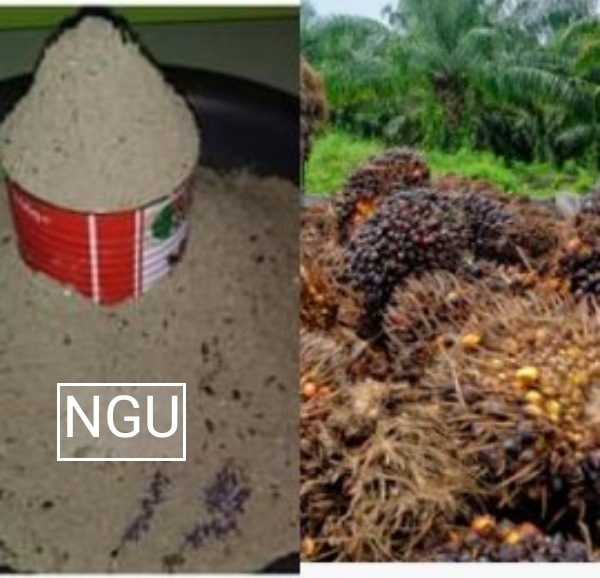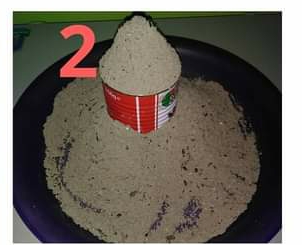Search Contents
How to Produce or Make Homemade Potash (Ngu)
I want to prepare my meal using homemade potash called “Ngu”. How do I produce it? In this post, we are going to teach you How to Produce or Make Homemade Potash (Ngu).
Potash is one of the natural resources. It is also known as Kaun, Akanwu, or Kanwa. It is a type of lake salt (sodium carbonate) that is dry and hydrated in nature. But this is not actually the kind of Potash I mean.
We are aware that the consumption of edible potash is not good for the body. So, reducing the intake is highly advisable. Burnt palm fruit stalk “ngu” is an alternative to edible potash.
Ngu
- First, Ngu or alternative to edible potash is palm fruits stalks or nests.
- It is the ashes gotten from burnt palm fruit stalks.
- It is the liquid we got when we mix the ashes with water and sieve it.
I want to talk about how to process and cook with locally made or homemade alternatives to edible potash called Ngu. Homemade alternative to edible potash, Ngu, is gotten from palm fruits nest or stalk known as “Aghirigha akwu” in Igbo dialect.
It can be called nests because that is where palm fruits form, grow, and ripe. It is made up of tiny sharp and piercing thorns. These nests or stalks are what form the head of palm fruits or nuts.
When the palm fruits ripen, they will be cut down in the bunch or head “ogbe akwu or isi akwu”. This head of the palm tree is either kept for some days for the palm fruits to loosen and fall out of the thorny nests or stalks are cut out, piece by piece with an Axe or machete.
I am taking the time to explain all of these because the nests or stalks are what are used in processing homemade potash or Akanwu. The locally-made alternative to potash is not called Akanwu in the Igbo dialect. It is known as Ngu.
In one of the articles, I discussed all kinds of Potash used in preparing sauces for Abacha, Isiewu, Kpomo, etc. I made mention of this kind of alternative to edible potash called Ngu. If you want to read about them, click here.
How to Produce or Make Homemade Potash (Ngu)
How Does Ngu Look Like?
Ngu, when processed, comes in ashes form. In fact, anyone who sees Ngu, at first sight, will think it is ashes. It takes strong eyes to differentiate between ashes and edible Potash ashes. When in doubt, the person usually employs the tip of the tongue.
Ngu ashes have a different taste. While ashes taste sour, Ngu ashes taste like heavy metallic on the tongue. But naturally, Ngu ashes or a homemade alternative to edible potash is darker than ordinary ashes.
So, How Do You Process or Produce this Homemade Potash aka Ngu?
Very simple. It is gotten from burnt palm fruits nest. See the image with number 1 above.
In the paragraphs above, I was telling you about palm head “ogbe akwu”. I was also describing what house palm fruits on the tree (aghirigha akwu).

Have you heard when someone is told that his head is like the head of the palm fruit (Isi akwu)? Palm fruits are formed in heads or stalks. When all the palm nuts are fallen out from the head or from the stalk, it remains the chaff or nest.
The chaff of the palm nuts head, after all the nuts have been removed comprises of the sharp thorny holes where palm nuts are formed, the palm nut cover or cap, the small dry leaves that cover the mouths of each palm fruits (afirifu), and the stem; a soft palm body where the nests are formed round.
When the palm nuts have been removed, these chaffs are kept under the sun to dry. They are set ablaze. The ashes gotten from this chaff are the homemade alternative to edible potash or Ngu.
Note that only the components of the palm tree are set ablaze to get local potash ashes. The only things to burn are the dried aghirigha akwu (Palm stalk). Nothing is added to them. Adding anything to them is adulterating the Ngu ash.
Make sure it burned into ashes. Then allow it to cool off and gather it with a clean pot with a lid. A well-burnt ngu should look like ashes but it is darker than ashes and smell nicer than it too.
How to Produce or Make Homemade Potash (Ngu)
Uses of Homemade Potash “Ngu”
Homemade alternative to edible potash or Ngu has been the original or the main cooking condiment for “Igba ncha“ (that is, locally made sauce). Ngu has been used for cooking meals like breadfruits and sauces before the Akanwu we are used to today becomes popular.
To date, the aged women still make the homemade potash part of their kitchen. You will hardly find the lake salt kind of Potash in their kitchens or see them cooking with it.
How to Use the Homemade potash (Ngu)
The way to use ordinary potash is almost the same way to use homemade potash. In fact, it is almost the same.
Homemade potash or Akanwu ashes are poured into a bowl and pour clean water. The water is used to turn it.
When you stir it, the water will become somehow dark. Get a sieve, a cheesecloth, or a clean handkerchief and sieve the water.
Collect the water and throw the chaff away. You may not use all the potash water. Discard the rest when you are done.
The Summary (How to Produce (Ngu) Alternative to Akanwu
Potash is among the natural resources known as Kaun, Akanwu, or Kanwa. Apart from this potash which is gotten from the ground and comes in the form of lake salt, there is another old way of producing an alternative to edible potash at home.
This type of homemade potash is known as Ngu in the Igbo language and that is what people have been using to cook in the time past.
How to Produce or Make Homemade Potash (Ngu). It is simply made of ashes gotten from the chaff or the stalk of the palm fruits’ heads.






